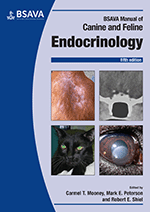
Full text loading...

This chapter provides an introduction to endocrine disease and the principles of endocrinology. It explains the role of hormones in intercellular communication and considers both traditional and modern endocrinology. The chapter also discusses the classification of hormones and their effects, as well as the mechanisms by which they exert their effects. The different types of endocrine disorders are introduced. The chapter concludes with guidance on recognition of endocrine disorders in the clinical setting, including a discussion of the use of diagnostic imaging techniques in endocrinology.
Principles of endocrine disease, Page 1 of 1
< Previous page | Next page > /docserver/preview/fulltext/10.22233/9781910443866/BSAVA_Manual_Canine_Feline_Endocrinology_5_9781910443866.1.1-5-1.gif

Full text loading...




